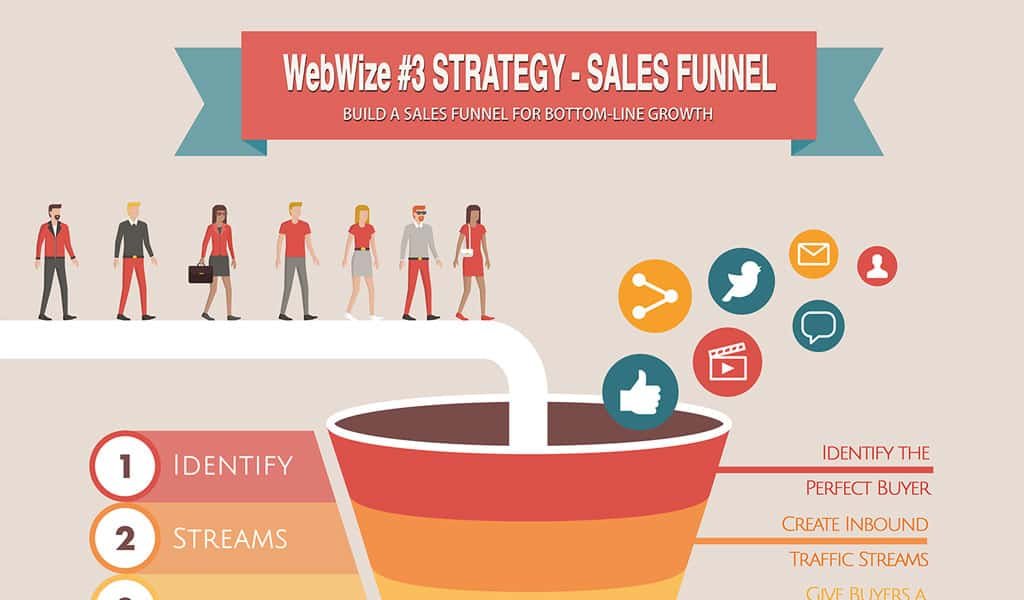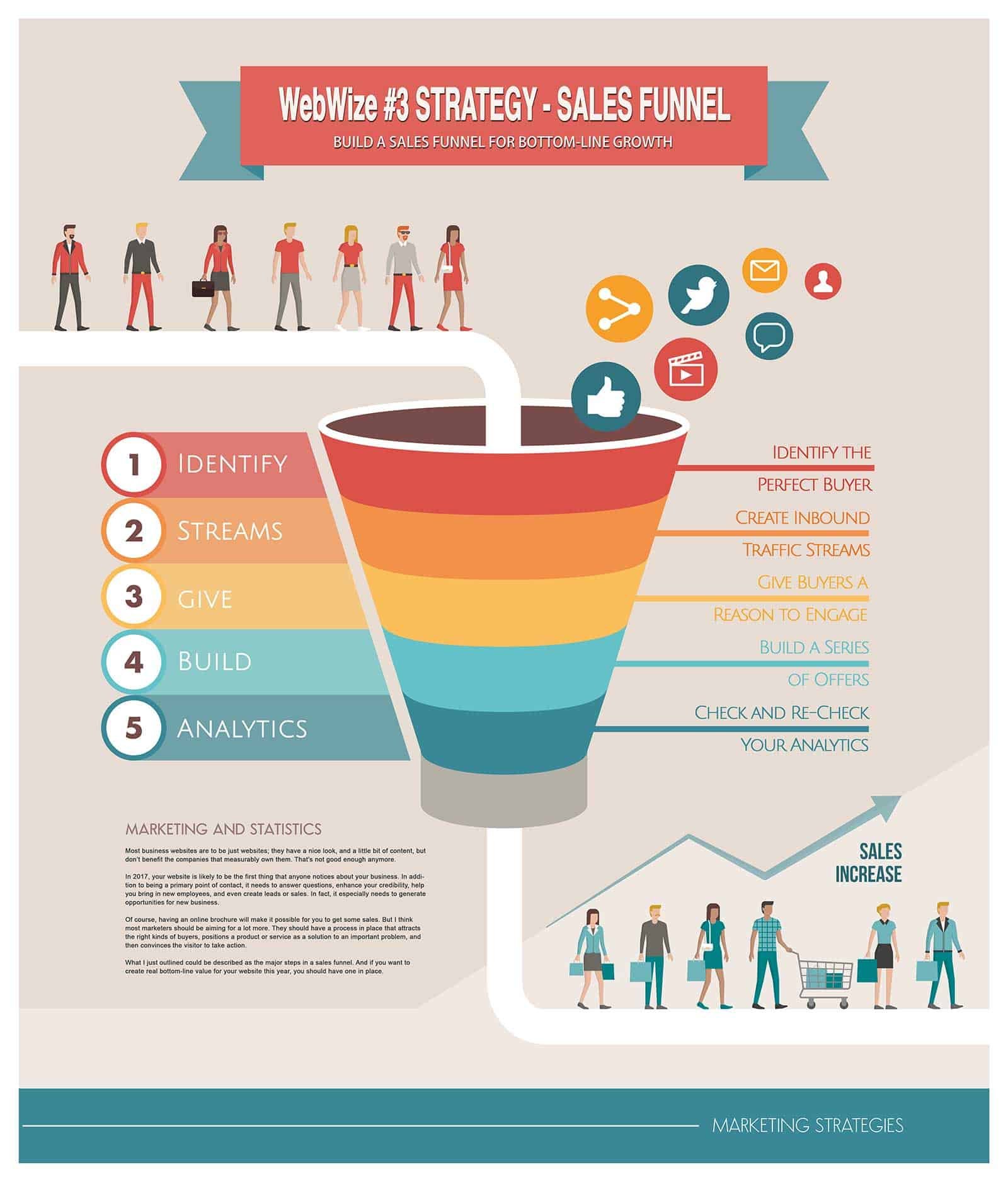Most business websites are to be just websites; they have a nice look, and a little bit of content, but don’t benefit the companies that measurably own them.
That’s not good enough anymore.
In 2017, your website is likely to be the first thing that anyone notices about your business. In addition to being a primary point of contact, it needs to answer questions, enhance your credibility, help you bring in new employees, and even create leads or sales. In fact, it especially needs to generate opportunities for new business.
Of course, having an online brochure will make it possible for you to get some sales. But I think most marketers should be aiming for a lot more. They should have a process in place that attracts the right kinds of buyers, positions a product or service as a solution to an important problem, and then convinces the visitor to take action.
What I just outlined could be described as the major steps in a sales funnel. And if you want to create real bottom-line value for your website this year, you should have one in place. In this strategy chapter, I want to walk you through the major elements so you can turn your website into a real engine of revenue growth…

Identify the Perfect Buyer
One of the biggest obstacles you can face on the road to creating and executing a winning internet marketing strategy is a lack of focus. While the web has made the world smaller, it has also taught us to be more specific and demanding than we used to be. Whereas a customer might have once visited a local shop looking for a “blue suit,” now they are just as likely to search on Google for a navy wool Italian two-piece outfit for $700 or less, including free two-day shipping.
To differentiate yourself, know where your value lies. Figure out what you can give customers that other companies can’t. Maybe it’s better pricing or more one-on-one attention. .
The point is that buyers tend to be better educated than they were in the past and that there are an endless number of competitors online. So if you can’t give customers what they want, they’ll look elsewhere.
One approach to this conundrum is to try to offer everything a customer could want. Whether it’s lower prices, fast shipping, or the best service and quality, some businesses claim they can do it all. In reality, though, that sort of philosophy tends to put a business out of business. You don’t go to a discount superstore and expect valet service. Likewise, the best restaurant in your town probably doesn’t have a value menu.
There are dozens of other examples, and you can be profitable with a business model that focuses on price, speed, unique products, or something else. The trick is that you have to know exactly what kinds of buyers make up your market, and why they would choose you instead of someone else. Without that knowledge, you are simply digging around for any sale you can make. That’s harmful because it eats away at your margins and leaves you vulnerable to another marketer who undercuts you on price, is closer to the customer, or makes an even better offer.
To differentiate yourself, know where your value lies. Figure out what you can give customers that other companies can’t. Maybe it’s better pricing or more one-on-one attention. Perhaps it’s an unbeatable location or even a unique style of marketing and communication.
From there, do your best (from looking back through your company’s history or conducting research) to figure out which segment of the market is most responsive to your kind of message. Identify them demographically, but also as individuals. In other words, look beyond things like age and income to see if you can figure out why they respond to certain offers and not to others.
It’s almost impossible to build strong sales funnel without knowing yourself, your audience, and the target market as a whole in painstaking detail. No one will respond to the content or offers you put online unless you can grab their attention and differentiate yourself first. Know that and take the time to not only find the information you need about your customers but keep looking for a better understanding of who they are and what they want.

Create Inbound Traffic Streams
In a lot of cases, business owners tend to pay too much attention to the process of generating traffic to their websites. In fact, we find that a lot of new clients equate online marketing with search engine optimization in a direct way. They tend to assume that if enough people find their websites, that will automatically result in sales.
For every thousand visitors you bring to your website, as an example, a certain percentage are going to turn into finished sales.
Unfortunately, that’s only a half-truth. You do have to have traffic to your website before you can use it to create online sales or new leads. However, having web traffic isn’t enough on its own. You need to have the right people coming to your website first, and then you need to persuade them to take action. I’m going to tackle new trends in search engine optimization, pay-per-click advertising, and social media in their chapters, but it’s worth noting that the other parts of the sales funnel will collapse without visits to your website.
The specific methods you use to bring buyers to your virtual front door are going to vary. Most companies we work with use a variety of tools, from SEO to email. Regardless of which ones you and your customers prefer, however, it’s important that your efforts be ongoing and consistent. For every thousand visitors you bring to your website, as an example, a certain percentage are going to turn into finished sales. The real challenge is to zero in on the right buyers, attract more of them, and increase the percentages at every step along the way.
Generating traffic to your website isn’t all there is to internet marketing, but it is a crucial first step. You have to know who your best potential customers are, and then find different ways of reaching out to them over the web. After that, it’s time to do something a lot of companies miss out on, and turn those views into sales opportunities.

Give Buyers a Reason to Engage
When you get someone who has the potential to become a great customer for your business to visit your website, it’s a big opportunity. However, if they leave without making a purchase, sharing their contact information, or deciding to return in the future, then the chance is lost. It’s unlikely that they’ll return, or that you will gain anything from their look at your website.
If you’re looking to create immediate sales rather than leads, you might offer customers a discount code, trackable coupon, or gift of some kind. Any of these can help nudge someone who is thinking about purchasing to take the next step.
A missed opportunity is why sites that are little more than online brochures are costing their owners money – they are wasting valuable chances to make a strong impression. If you want to build a sales funnel that makes a noticeable impact on your bottom line, you have to do better.
The best way to engage buyers who have found their way to your website is to create a series of offers that create a response. Don’t just tell them who you are and what you’re about; give them the opportunity to take an action that brings them closer to the solution they are looking for while also improving the odds they’ll do business with you.
A classic example of a lead-capturing offer would be a downloadable e-book. A prospect has to share their name and email address to receive their copy, but they get a valuable resource that can help them better understand the challenge they are facing. Meanwhile, you as a marketer get a great way to follow up and make more offers in the future.
You could achieve the same effect with a video series, a native mobile app, or some personalized tool. For example, my company often provides free website audits and account reviews. Those can be extraordinarily valuable to clients, while at the same time giving us an opportunity to show off our capabilities.
If you’re looking to create immediate sales rather than leads, you might offer customers a discount code, trackable coupon, or gift of some kind. Any of these can help nudge someone who is thinking about purchasing to take the next step.
The important thing about your first offer is that it is targeted to the specific buyers you’re trying to attract and that it has a clear and immediate value to them. It also helps if the offer boosts your value, too, by showing the quality or expertise you have to solve problems. If someone comes to your website looking for answers, responding positively to your offer should be an easy decision. When that happens, they’ve entered your sales funnel, and the chances that you’ll win their business have increased dramatically.

Build a Series of Offers
You might have a simple product or service that only requires one offer. If you ran a carwash company, for instance, giving a time-limited coupon for 20% off auto detailing might be enough to keep drivers coming in and out of your business all day long. The more complex your product or industry, though, the more important it is for you to create a series of offers that work in a logical order.
Someone who signs up for a report or email newsletter, for instance, can be sent new updates without taking time away from a business owner or salesperson.
To give another example, most people wouldn’t work with the first mortgage broker they could find. They would likely check out several websites and do quite a bit of homework before selecting an individual or company. That’s a process that could take a great deal of time, even months or years.
Knowing that a mortgage broker might create an initial offer that included a refinancing checklist, a first-time home buyer guide, or a video outlining the home inspection process. Once a visitor had registered on a website to get this information, they could follow up with regular emails updating the subscriber about current mortgage rates. They can also promote more detailed and personalized offers, such as payment calculators and links to local listings.
What I’ve outlined is just a simple hypothetical sales funnel, but the point is that one offer won’t always be enough to get buyers to move forward. That’s why a set of ongoing calls to action should be built directly into the sales funnel. These keep the potential customer engaged with the business, allow the marketer to collect more information about the account (if needed), and further position your company as a valuable resource.
A side effect of a multi-tiered sales funnel is that it can be automated. Someone who signs up for a report or email newsletter, for instance, can be sent new updates without taking time away from a business owner or salesperson. Whether there are ten people on the list or a thousand, the campaign can keep moving forward flawlessly.
These subsequent offers also serve another, often underappreciated purpose. As buyers receive follow-up messages and subsequent offers, they’ll start to realize whether a particular company, product or service is or isn’t right for them. If the fit is a good one, they can keep moving forward or contact the business directly. If it isn’t, they can opt to stop receiving messages.
That might seem like a negative outcome for the marketer, but it saves a lot of time and frustration. After all, it’s hard enough to follow up with the valuable leads. Why waste more time than necessary chasing after a customer who isn’t going to work with you?

Check and Re-Check Your Analytics
“Pay attention to your web analytics” is going to be a recurring theme in this book. There’s a good reason for that: I’ve found that many of the business owners and executives who began working with us have shied away from digging into their web statistics. Perhaps they feel intimidated by the graphs and percentages, or maybe it’s because they are afraid of what they might see, but most are happier to keep doing what they are already doing without digging too far into the numbers.
You’ll never find the answer, though, if you aren’t paying close attention to who you have come to your website and what they do when they arrive.
Note using available site analytics or site stats is a shortsighted approach, though. It might make you feel better in the short term, but it certainly isn’t going to help your website or business succeed over time. Without knowing how customers are reacting to your pages and content, it’s impossible to give them more of what they want.
This is particularly true when it comes to building and refining your sales funnels. Some of the buyers you are targeting are going to respond wonderfully to the discounts and resources you throw at them. Others are going to be indifferent. When that happens, you have to figure out which pieces of your plan can be kept, and which ones have to be changed. You may need to set your sights on a different demographic, offer a new informational guide, or tweak your coupon in some way. You’ll never find the answer, though, if you aren’t paying close attention to who you have come to your website and what they do when they arrive.
Besides, the language of web analytics isn’t all that complicated. After you get familiar with a few key concepts, you’ll not only be comfortable evaluating your website, but you’ll start to notice certain trends developing.
It’s fine to create sales funnels from inspiration and experience, but if analytics doesn’t drive them, you are going to be losing out on sales and potential revenue. So, rather than running from the stats and figures that are going to drive your future revenue growth, use them to find ways to get better.
Sales Funnels Make Websites Profitable
A website that tells the general public about your company can be useful, especially in this day and age where customers turn to Google for recommendations before they buy just about anything. But, for a web presence to be profitable, it has to attract and convert new customers regularly.
That job gets a lot easier when you have strong sales funnel in place. Don’t treat the jobs of generating traffic, creating offers, and growing revenue as separate tasks because they are all created to work together. Once you know your customers, your business, and your goal, building an efficient online engine for leads and sales should be your top priority.
10-Point Strategy Guide to Small Business Website Design and Internet Marketing is a ten part Blog series by Founder and Owner of WebWize, Inc., Glenn Brooks.
Glenn has been part of the website design and development industry since 1994, over two decades. Before WebWize he spent more than 15 years in the Advertising, Marketing, and Print Industries. Don't miss this opportunity!
10 Part Strategy Series TOC
Strategy #1: Give Your Website a Job
Strategy #2: Emphasize Website Performance and UX
Strategy #3: Build a Sales Funnel for Bottom-Line Growth
Strategy #4: Understand the New Age of Search Engine Optimization
Strategy #5: Make Your PPC Campaigns as Efficient as Possible
Strategy #6: Use Social Media Productively
Strategy #7: Integrate Video Into Your Internet Marketing
Strategy #8: Revitalize Your Email Marketing
Strategy #9: Cultivate and Grow Your Online Reputation
Strategy #10: Refine and Improve Your Sales Funnel
About Glenn Brooks
Glenn Brooks is the founder of WebWize, Inc. WebWize has provided web design, development, hosting, SEO and email services since 1994. Glenn graduated from SWTSU with a degree in Commercial Art and worked in the advertising, marketing, and printing industries for 18 years before starting WebWize.


